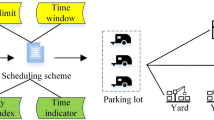Abstract
Transportation of hazardous materials (Hazmat) is one of the most important aspects of transportation planning, which poses several risks to the physical and social environment. These risks have become one of the most important concerns of planners, and as a result, any considerations that can reduce costs and environmental risks are important. Since establishing an intermodal transportation network by different modes of transportation have a key role in transportation planning of hazmat, and lack of proper decision-making may impose high costs and endanger society, in this research, for the first time, the problem of routing and intermodal terminal location is considered simultaneously. This problem is formulated as a mixed-integer nonlinear programming problem for load management of regular and hazmat freights by the railroad intermodal transportation that considers congestion in multiple states and determines the appropriate equipment capacity. In order to validate the proposed model with the objective functions of minimizing the total transportation risk and operating costs, different test problems are solved by the elastic method. Due to the computational complexity of the problem, a metaheuristic algorithm, namely sub-population genetic algorithm (SPGA), is also developed to obtain near-optimal Pareto solutions. In addition, several experiments are provided to compare the SPGA and multi-objective particle swarm optimization, which has recently been presented in the literature. Finally, the obtained results are analyzed, and the efficiency of the algorithm is examined using some performance metrics.














Similar content being viewed by others
References
Abbassi, A., Elhilali Alaoui, A., & Boukachour, J. (2018). Modelling and solving a bi-objective intermodal transport problem of agricultural products. International Journal of Industrial Engineering Computations, 9, 439–460.
Abbassi, A., El Hilali Alaoui, A., & Boukachour, J. (2019). Robust optimization of the intermodal freight transport problem: Modeling and solving with an efficient hybrid approach. Journal of Computational Science, 30, 127–142.
Abuobidalla, O., Chen, M., & Chauhan, S. A. (2019). Metaheuristics method for planning railway freight transportation with hazardous materials. Journal of Rail Transport Planning and Management, 10, 46–61.
Ardjmand, E., Weckman, G., Park, N., Taherkhani, P., & Singh, M. (2015). Applying genetic algorithm to a new location and routing model of hazardous materials. International Journal of Production Research, 53, 916–928.
Assadipour, G., Ke, G. Y., & Verma, M. (2015). Planning and managing intermodal transportation of hazardous materials with capacity selection and congestion. Transportation Research Part e: Logistics and Transportation Review, 76, 45–57.
Assadipour, G. H., Ke, G. Y., & Verma, M. (2016). A toll-based bi-level programming approach to managing hazardous materials shipments over an intermodal transportation network. Transportation Research Part D, 47, 208–221.
Behnamian, J., Fatemi Ghomi, S. M. T., & Zandieh, M. (2009). A multi-phase covering pareto-optimal front method to multi-objective scheduling in a realistic hybrid flowshop using a hybrid metaheuristic. Expert Systems with Applications, 36, 11057–11069.
Chai, H., He, R., Ma, Ch., Dai, C., & Zhou, K. (2017). Path planning and vehicle scheduling optimization for logistic distribution of hazardous materials in full container load. Discrete Dynamics in Nature and Society. https://doi.org/10.1155/2017/9685125
Dantzig, G. B., & Ramser, J. H. (1959). The truck dispatching problem. Management Science, 6, 80–91.
Ehrgott, M., & Ryan, D. M. (2002). Constructing robust crew schedules with bi-criteria optimization. Journal of Multi-Criteria Decision Analysis, 11(3), 139–150.
Esfandeh, T., Batta, R., & Kwonc, Ch. (2017). Time-dependent hazardous-materials network design problem. Transportation Science, 52(2), 454–473.
European agreement concerning the international carriage of dangerous goods by road 2003 [ADR 2003].
Faghih-Roohi, S., Ong, Y. S., & Asian, S. (2016). Dynamic conditional value-at-risk model for routing and scheduling of hazardous material transportation networks. Annals of Operations Research, 247, 715–734.
Fang, K., Ke, G. Y., & Verma, M. (2017). A routing and scheduling approach to rail transportation of hazardous materials with demand due dates. European Journal of Operational Research, 261, 154–168.
Fazayeli, S., Eydi, A., & Nakhai Kamalabadi, I. (2018a). A model for distribution centers location-routing problem on a multimodal transportation network with a metaheuristic solving approach. Journal of Industrial Engineering International, 14, 327–342.
Fazayeli, S., Eydi, A., & Nakhai Kamalabadi, I. (2018b). Location-routing problem in multimodal transportation network with time windows and fuzzy demands: Presenting a two-part genetic algorithm. Computers Industrial Engineering, 119, 233–246.
Fontaine, P., Gabriel Crainic, T., Gendreau, M., & Minner, S. (2020). Population-based risk equilibration for the multimode hazmat transport network design problem. European Journal of Operational Research, 284, 188–200.
Ghaderi, A., & Burdett, R. L. (2019). An integrated location and routing approach for transporting hazardous materials in a bi-modal transportation network. Transportation Research Part E, 127, 49–65.
Ghane-Ezabadi, M., & Vergara, H. A. (2016). Decomposition approach for integrated intermodal logistics network design. Transportation Research Part E, 89, 53–69.
Heggen, H., Molenbruch, Y., Caris, A., & Braekers, K. (2019). Intermodal container routing: integrating long-haul routing and local drayage decisions. Sustainability. https://doi.org/10.3390/su11061634
Hicks, C. R., & Turner, K. V. (1999). Fundamental concepts in the design of experiments (5th edn). Oxford University Press.
Holeczek, N. (2019). Hazardous materials truck transportation problems: a classification and state of the art literature review. Transportation Research Part D, 69, 305–328.
Hou, J. (2017). Intermodal transport problem of container terminal in emission control area.
Hu, H., Li, X., Zhang, Y., Shang, C. H., & Zhang, S. (2019). Multi-objective location-routing model for hazardous material logistics with traffic restriction constraint in inter-city roads. Computers Industrial Engineering, 128, 861–876.
Jiang, Y., Zhang, X., Rong, Y., & Zhang, Z. (2014). A multimodal location and routing model for hazardous materials transportation based on multi-commodity flow model. Procedia-Social and Behavioral Sciences, 138, 791–799.
Ke, Y. G. (2020). Managing rail-truck intermodal transportation for hazardous materials with random yard disruptions. Annals of Operations Research. https://doi.org/10.1007/s10479-020-03699-1
Li, S., Sun, S., Wang, Y.-Q., Wu, Y., & Liu, L. (2017). A two-stage stochastic programming model for rail-truck intermodal network design with uncertain customer demand. Journal of Interdisciplinary Mathematics, 20, 611–621.
Mahmoudsoltani, F., Shahbandarzadeh, H., & Moghdani, R. (2018). Using Pareto-based multi-objective Evolution algorithms in decision structure to transfer the hazardous materials to safety storage center. Journal of Cleaner Production, 184, 893–911.
Mehran, B., Ahmad Khan, M., Mehran, M., Roh, H., & Sharma, S. (2019). Case study scenarios in site selection of hazardous material facilities based on transportation preferences. Journal of Modern Transportation, 27, 317–333.
Moving Goods in the United States US Department of Transportation. (2019). Bureau of Transportation Statistics. Freight Facts and Figures, Washington, DC. Retrieved from https://data.bts.gov/stories/s/Moving-Goods-in-the-United-States/bcyt-rqmu
Munim, Z. H., & Haralambides, H. (2018). Competition and cooperation for intermodal container transshipment: A network optimization approach. Research in Transportation Business & Management, 26, 87–99.
Rabbani, M., Heidari, R., Farrokhi-Asl, H., & Rahimi, N. (2018). Using metaheuristic algorithms to solve a multiobjective industrial hazardous waste location-routing problem considering incompatible waste types. Journal of Cleaner Production, 170, 227–241.
Rahman, H. F., & Nielsen, I. (2019). Scheduling automated transport vehicles for material distribution systems. Applied Soft Computing Journal, 82, 105552.
Sarhadi, H., Tulett, D. M., & Verma, M. (2017). An analytical approach to the protection planning of a rail intermodal terminal network. European Journal of Operational Research, 257(2), 511–525.
Schott, J. R. (1995). Design using single and multi-criteria genetic algorithms. Master’s Thesis, Department of Aeronautics and Astronautics, Massachusetts Institute of Technology, Boston.
Shapiro, S. S., & Wilk, M. B. (1965). An analysis of variance test for normality (complete samples). Biometrika, 52(3–4), 591–611.
Shobrys, D. E. (1981). A model for the selection of shipping routes and storage locations for a hazardous substance. Ph.D. Thesis, Johns Hopkins University, Baltimore.
Szeto, W. Y., Farahani, R. Z., & Sumalee, A. (2017). Link-based multi-class hazmat routing-scheduling problem: A multiple demon approach. European Journal of Operational Research, 261(16), 337–354.
Verma, M., Verter, V., & Zufferey, N. (2012). A bi-objective model for planning and managing rail-truck intermodal transportation of hazardous materials. Transportation Research Part e: Logistics and Transportation Review, 48, 132–149.
Xie, Y., Lu, W., Wang, W., & Quadrifoglio, L. (2012). A multimodal location and routing model for hazardous materials transportation. Journal of Hazardous Materials, 227, 135–141.
Zhao, J., & Ke, G. (2019). Optimizing emergency logistics for the offsite hazardous waste management. Journal of Systems Science and Systems Engineering, 28, 747–765.
Zhao, J., & Verter, V. (2015). A bi-objective model for the used oil location-routing problem. Computers Operations Research, 62, 157–168.
Zhao, J., Zhu, X., Liu, Y., Wang, L., & Yan, B. (2018). A practical model for inbound container distribution organization in rail-water transshipping terminal. Journal of Control Science and Engineering. https://doi.org/10.1155/2018/9148405
Zitzler, E. (1999). Evolutionary algorithm for Multi-objective optimization: Methods and applications. Ithaca: Shaker, 63.
Zografos, K. G., & Androutsopoulos, K. N. (2004). A heuristic algorithm for solving hazardous materials distribution problems. European Journal of Operational Research, 152, 507–519.
Author information
Authors and Affiliations
Corresponding author
Additional information
Publisher's Note
Springer Nature remains neutral with regard to jurisdictional claims in published maps and institutional affiliations.
Rights and permissions
About this article
Cite this article
Fattahi, Z., Behnamian, J. Location and transportation of intermodal hazmat considering equipment capacity and congestion impact: elastic method and sub-population genetic algorithm. Ann Oper Res 316, 303–341 (2022). https://doi.org/10.1007/s10479-021-04201-1
Accepted:
Published:
Issue Date:
DOI: https://doi.org/10.1007/s10479-021-04201-1




